Study of Temporal Variations of Equivalent Black Carbon in a Coastal City in Northwest Spain Using an Atmospheric Aerosol Data Management Software
Abstract
1. Introduction
2. Materials and Methods
2.1. Measurement Site
2.2. Instrumentation
2.3. SCALA© (Version 1.1, UDC-CIEMAT, Spain)
- Group manager: Responsible for a group of environmental technicians. She/he manages the members and the measuring instruments of her/his group, votes in surveys about the campaigns the group has been invited to, and sets the configuration for the group equipment in campaigns.
- Campaign manager: The group manager that registers a campaign in SCALA© and, therefore, is responsible for managing the campaign life cycle (i.e., invitations to groups for participation in the campaign, campaign surveys for date and place agreement, campaign opening and campaign closing).
- Technical user: A member belonging to a group of environmental technicians. Its main features are the following: Data files, documentation and incident uploads, and intra- and inter-campaign analysis (data files selection, charts selection, and exportation options selection).
3. Results and Discussion
3.1. eBC Mass Concentrations
3.2. UFP
3.3. Source Apportionment of eBC
4. Conclusions
Author Contributions
Funding
Institutional Review Board Statement
Informed Consent Statement
Data Availability Statement
Acknowledgments
Conflicts of Interest
References
- Alonso-Blanco, E.; Gómez-Moreno, F.J.; Artíñano, B.; Iglesias-Samitier, S.; Juncal-Bello, V.; Piñeiro-Iglesias, M.; López-Mahía, P.; Pérez, N.; Brines, M.; Alastuey, A.; et al. Temporal and spatial variability of atmospheric particle number size distributions across Spain. Atmos. Environ. 2018, 190, 146–160. [Google Scholar] [CrossRef]
- Fermo, P.; Comite, V.; Ciantelli, C.; Sardella, A.; Bonazza, A. A multi-analytical approach to study the chemical composition of total suspended particulate matter (TSP) to assess the impact on urban monumental heritage in Florence. Sci. Total Environ. 2020, 740, 140055. [Google Scholar] [CrossRef] [PubMed]
- Fuzzi, S.; Baltensperger, U.; Carslaw, K.; Decesari, S.; Denier Van Der Gon, H.; Facchini, M.C.; Fowler, D.; Koren, I.; Langford, B.; Lohmann, U.; et al. Particulate matter, air quality and climate: Lessons learned and future needs. Atmos. Chem. Phys. 2015, 15, 8217–8299. [Google Scholar] [CrossRef]
- Titos, G.; Lyamani, H.; Drinovec, L.; Olmo, F.J.; Močnik, G.; Alados-Arboledas, L. Evaluation of the impact of transportation changes on air quality. Atmos. Environ. 2015, 114, 19–31. [Google Scholar] [CrossRef]
- Atzei, D.; Fermo, P.; Vecchi, R.; Fantauzzi, M.; Comite, V.; Valli, G.; Cocco, F.; Rossi, A. Composition and origin of PM2.5 in Mediterranean Countryside. Environ. Pollut. 2019, 246, 294–302. [Google Scholar] [CrossRef] [PubMed]
- Yang, Y.; Ruan, Z.; Wang, X.; Yang, Y.; Mason, T.G.; Lin, H.; Tian, L. Short-term and long-term exposures to fine particulate matter constituents and health: A systematic review and meta-analysis. Environ. Pollut. 2019, 247, 874–882. [Google Scholar] [CrossRef]
- Sandradewi, J.; Prévôt, A.S.H.; Szidat, S.; Perron, N.; Alfarra, M.R.; Lanz, V.A.; Weingartner, E.; Baltensperger, U. Using aerosol light absorption measurements for the quantitative determination of wood burning and traffic emission contributions to particulate matter. Environ. Sci. Technol. 2008, 42, 3316–3323. [Google Scholar] [CrossRef]
- Sandradewi, J.; Prévôt, A.S.H.; Weingartner, E.; Schmidhauser, R.; Gysel, M.; Baltensperger, U. A study of wood burning and traffic aerosols in an Alpine valley using a multi-wavelength Aethalometer. Atmos. Environ. 2008, 42, 101–112. [Google Scholar] [CrossRef]
- Drinovec, L.; Močnik, G.; Zotter, P.; Prévôt, A.S.H.; Ruckstuhl, C.; Coz, E.; Rupakheti, M.; Sciare, J.; Müller, T.; Wiedensohler, A.; et al. The “dual-spot” Aethalometer: An improved measurement of aerosol black carbon with real-time loading compensation. Atmos. Meas. Tech. 2015, 8, 1965–1979. [Google Scholar] [CrossRef]
- Hansen, A.D.A.; Rosen, H.; Novakov, T. The aethalometer—An instrument for the real-time measurement of optical absorption by aerosol particles. Sci. Total Environ. 1984, 36, 191–196. [Google Scholar] [CrossRef]
- Yttri, K.E.; Platt, S.M.; Aas, W.; Solberg, S.; Aurela, M.; Bergmans, B.; Lenartz, F.; Lazzeri, P.; Luoma, K.; Pandolfi, M.; et al. Transboundary particulate matter, photo-oxidants, acidifying and eutrophying components. EMEP Status report 1/2018. In Transboundary Particulate Matter, Photo-Oxidants, Acidifying and Eutrophying Components. EMEP Status Report 1/2018; Fagerli, H., Tsyro, S., Jonson, J.E., Nyíri, Á., Gauss, M., Simpson, D., Wind, P., Benedictow, A., Valdebenito, A., Klein, H., et al., Eds.; EMEP: Oslo, Norway, 2018; pp. 99–106. [Google Scholar]
- Lack, D.A.; Moosmüller, H.; Mcmeeking, G.R.; Chakrabarty, R.K.; Baumgardner, D. Characterizing elemental, equivalent black, and refractory black carbon aerosol particles: A review of techniques, their limitations and uncertainties. Anal. Bioanal. Chem. 2014, 406, 99–122. [Google Scholar] [CrossRef] [PubMed]
- Petzold, A.; Ogren, J.A.; Fiebig, M.; Laj, P.; Li, S.-M.; Baltensperger, U.; Holzer-Popp, T.; Kinne, S.; Pappalardo, G.; Sugimoto, N.; et al. Recommendations for reporting “black carbon” measurements. Atmos. Chem. Phys. 2013, 13, 8365–8379. [Google Scholar] [CrossRef]
- Querol, X.; Alastuey, A.; Viana, M.; Moreno, T.; Reche, C.; Minguillón, M.C.; Ripoll, A.; Pandolfi, M.; Amato, F.; Karanasiou, A.; et al. Variability of carbonaceous aerosols in remote, rural, urban and industrial environments in Spain: Implications for air quality policy. Atmos. Chem. Phys. 2013, 13, 6185–6206. [Google Scholar] [CrossRef]
- Hama, S.M.L.; Cordell, R.L.; Kos, G.P.A.; Weijers, E.P.; Monks, P.S. Sub-micron particle number size distribution characteristics at two urban locations in Leicester. Atmos. Res. 2017, 194, 1–16. [Google Scholar] [CrossRef]
- Harrison, R.M.; Jones, A.M.; Lawrence, R.G. Major component composition of PM10 and PM2.5 from roadside and urban background sites. Atmos. Environ. 2004, 38, 4531–4538. [Google Scholar] [CrossRef]
- Smargiassi, A.; Baldwin, M.; Pilger, C.; Dugandzic, R.; Brauer, M. Small-scale spatial variability of particle concentrations and traffic levels in Montreal: A pilot study. Sci. Total Environ. 2005, 338, 243–251. [Google Scholar] [CrossRef] [PubMed]
- Rodríguez, S.; Cuevas, E. The contributions of “minimum primary emissions” and “new particle formation enhancements” to the particle number concentration in urban air. J. Aerosol Sci. 2007, 38, 1207–1219. [Google Scholar] [CrossRef]
- Costabile, F.; Alas, H.; Aufderheide, M.; Avino, P.; Amato, F.; Argentini, S.; Barnaba, F.; Berico, M.; Bernardoni, V.; Biondi, R.; et al. First Results of the “Carbonaceous Aerosol in Rome and Environs (CARE)” Experiment: Beyond Current Standards for PM10. Atmosphere 2017, 8, 249. [Google Scholar] [CrossRef]
- Sun, J.; Birmili, W.; Hermann, M.; Tuch, T.; Weinhold, K.; Spindler, G.; Schladitz, A.; Bastian, S.; Löschau, G.; Cyrys, J.; et al. Variability of black carbon mass concentrations, sub-micrometer particle number concentrations and size distributions: Results of the German Ultrafine Aerosol Network ranging from city street to High Alpine locations. Atmos. Environ. 2019, 202, 256–268. [Google Scholar] [CrossRef]
- Del Águila, A.; Sorribas, M.; Lyamani, H.; Titos, G.; Olmo, F.J.; Arruda-Moreira, G.; Yela, M.; Alados-Arboledas, L. Sources and physicochemical characteristics of submicron aerosols during three intensive campaigns in Granada (Spain). Atmos. Res. 2018, 213, 398–410. [Google Scholar] [CrossRef]
- Andreae, M.O.; Gelencsér, A. Black carbon or brown carbon? The nature of light-absorbing carbonaceous aerosols. Atmos. Chem. Phys. 2006, 6, 3131–3148. [Google Scholar] [CrossRef]
- Chakrabarty, R.K.; Gyawali, M.; Yatavelli, R.L.N.; Pandey, A.; Watts, A.C.; Knue, J.; Chen, L.-W.A.; Pattison, R.R.; Tsibart, A.; Samburova, V.; et al. Brown carbon aerosols from burning of boreal peatlands: Microphysical properties, emission factors, and implications for direct radiative forcing. Atmos. Chem. Phys. 2016, 16, 3033–3040. [Google Scholar] [CrossRef]
- Schnaiter, M.; Horvath, H.; Möhler, O.; Naumann, K.-H.; Saathoff, H.; Schöck, O.W. UV-VIS-NIR spectral optical properties of soot and soot-containing aerosols. J. Aerosol Sci. 2003, 34, 1421–1444. [Google Scholar] [CrossRef]
- Moreda-Piñeiro, J.; Alonso-Rodríguez, E.; Moscoso-Pérez, C.; Blanco-Heras, G.; Turnes-Carou, I.; López-Mahía, P.; Muniategui-Lorenzo, S.; Prada-Rodríguez, D. Influence of marine, terrestrial and anthropogenic sources on ionic and metallic composition of rainwater at a suburban site (northwest coast of Spain). Atmos. Environ. 2014, 88, 30–38. [Google Scholar] [CrossRef]
- Gómez-Moreno, F.J.; Alonso, E.; Artíñano, B.; Juncal-Bello, V.; Iglesias-Samitier, S.; Piñeiro Iglesias, M.; Mahía, P.L.; Pérez, N.; Pey, J.; Ripoll, A.; et al. Intercomparisons of Mobility Size Spectrometers and Condensation Particle Counters in the Frame of the Spanish Atmospheric Observational Aerosol Network. Aerosol Sci. Technol. 2015, 49, 777–785. [Google Scholar] [CrossRef]
- Vintar Mally, K.; Planinšek, A.; Gregorič, A.; Drinovec, L.; Močnik, G.; Koblar, S.; Koželj, T.; Bobovnik, N. Nitrogen Dioxide and Black Carbon Concentrations in Ljubljana; Znanstvena Založba Filozofske Fakultete: Ljubljana, Slovenia, 2017; ISBN 9789612379803. [Google Scholar]
- Favez, O.; Cachier, H.; Sciare, J.; Sarda-Estève, R.; Martinon, L. Evidence for a significant contribution of wood burning aerosols to PM2.5 during the winter season in Paris, France. Atmos. Environ. 2009, 43, 3640–3644. [Google Scholar] [CrossRef]
- Kirchstetter, T.W.; Novakov, T.; Hobbs, P.V. Evidence that the spectral dependence of light absorption by aerosols is affected by organic carbon. J. Geophys. Res. Atmos. 2004, 109, D21208. [Google Scholar] [CrossRef]
- Russell, P.B.; Bergstrom, R.W.; Shinozuka, Y.; Clarke, A.D.; DeCarlo, P.F.; Jimenez, J.L.; Livingston, J.M.; Redemann, J.; Dubovik, O.; Strawa, A. Absorption Angstrom Exponent in AERONET and related data as an indicator of aerosol composition. Atmos. Chem. Phys. 2010, 10, 1155–1169. [Google Scholar] [CrossRef]
- Zotter, P.; Herich, H.; Gysel, M.; El-Haddad, I.; Zhang, Y.; Močnik, G.; Hüglin, C.; Baltensperger, U.; Szidat, S.; Prévôt, A.S.H. Evaluation of the absorption Ångström exponents for traffic and wood burning in the Aethalometer-based source apportionment using radiocarbon measurements of ambient aerosol. Atmos. Chem. Phys. 2017, 17, 4229–4249. [Google Scholar] [CrossRef]
- Andrade-Garda, J.; Suárez-Garaboa, S.; Álvarez-Rodríguez, A.; Piñeiro-Iglesias, M.; López-Mahía, P.; Gómez-Moreno, F.J.; Artíñano, B. Development of a web software application for nanoparticle data management and analysis. In Proceedings of the 4th Iberian Meeting on Aerosol Science and Technology RICTA’16, Aveiro, Portugal, 29 June–1 July 2016. [Google Scholar]
- Andrade-Garda, J.; Suárez-Garaboa, S.; Álvarez-Rodríguez, A.; Piñeiro-Iglesias, M.; López-Mahía, P.; Díaz-Ramiro, E.; Artíñano, B.; Gómez-Moreno, F.J. Web Application for Atmospheric Aerosol Data Management: Software and Case Study in the Spanish Network on Environmental Differential Mobility Analysers. Atmosphere 2019, 10, 279. [Google Scholar] [CrossRef]
- Andrade, J.; Ares, J.; García, R.; Presa, J.; Rodríguez, S.; Piñeiro-Iglesias, M.; López-Mahía, P.; Muniategui, S.; Prada, D. Development of a Web-based Support System for Both Homogeneous and Heterogeneous Air Quality Control Networks: Process and Product. Environ. Monit. Assess. 2007, 133, 139–148. [Google Scholar] [CrossRef]
- R Core Team. R: A Language and Environment for Statistical Computing, version 3.4.4.; R Foundation for Statistical Computing: Vienna, Austria, 2018. [Google Scholar]
- Wiedensohler, A.; Birmili, W.; Nowak, A.; Sonntag, A.; Weinhold, K.; Merkel, M.; Wehner, B.; Tuch, T.; Pfeifer, S.; Fiebig, M.; et al. Mobility particle size spectrometers: Harmonization of technical standards and data structure to facilitate high quality long-term observations of atmospheric particle number size distributions. Atmos. Meas. Tech. 2012, 5, 657–685. [Google Scholar] [CrossRef]
- Carslaw, D.C.; Ropkins, K. Openair—An R package for air quality data analysis. Environ. Model. Softw. 2012, 27–28, 52–61. [Google Scholar] [CrossRef]
- Becerril-Valle, M.; Coz, E.; Prévôt, A.S.H.; Močnik, G.; Pandis, S.N.; Sánchez de la Campa, A.M.; Alastuey, A.; Díaz, E.; Pérez, R.M.; Artíñano, B. Characterization of atmospheric black carbon and co-pollutants in urban and rural areas of Spain. Atmos. Environ. 2017, 169, 36–53. [Google Scholar] [CrossRef]
- Helin, A.; Niemi, J.V.; Virkkula, A.; Pirjola, L.; Teinilä, K.; Backman, J.; Aurela, M.; Saarikoski, S.; Rönkkö, T.; Asmi, E.; et al. Characteristics and source apportionment of black carbon in the Helsinki metropolitan area, Finland. Atmos. Environ. 2018, 190, 87–98. [Google Scholar] [CrossRef]
- Kucbel, M.; Corsaro, A.; Švédová, B.; Raclavská, H.; Raclavský, K.; Juchelková, D. Temporal and seasonal variations of black carbon in a highly polluted European city: Apportionment of potential sources and the effect of meteorological conditions. J. Environ. Manag. 2017, 203, 1178–1189. [Google Scholar] [CrossRef]
- Singh, V.; Ravindra, K.; Sahu, L.; Sokhi, R. Trends of atmospheric black carbon concentration over the United Kingdom. Atmos. Environ. 2018, 178, 148–157. [Google Scholar] [CrossRef]
- Mousavi, A.; Sowlat, M.H.; Lovett, C.; Rauber, M.; Szidat, S.; Boffi, R.; Borgini, A.; De Marco, C.; Ruprecht, A.A.; Sioutas, C. Source apportionment of black carbon (BC) from fossil fuel and biomass burning in metropolitan Milan, Italy. Atmos. Environ. 2019, 203, 252–261. [Google Scholar] [CrossRef]
- Uria-Tellaetxe, I.; Carslaw, D.C. Conditional bivariate probability function for source identification. Environ. Model. Softw. 2014, 59, 1–9. [Google Scholar] [CrossRef]
- Carslaw, D. The openair manual—Open-source tools for analysing air pollution data. Man. Version 2019, 1–224. [Google Scholar]
- Grigg, J. Arrhythmias and particulate matter. Lancet Planet. Health 2017, 1, e50–e51. [Google Scholar] [CrossRef]
- Wang, Y.; Hopke, P.K.; Rattigan, O.V.; Xia, X.; Chalupa, D.C.; Utell, M.J. Characterization of residential wood combustion particles using the two-wavelength aethalometer. Environ. Sci. Technol. 2011, 45, 7387–7393. [Google Scholar] [CrossRef] [PubMed]
- Németh, Z.; Rosati, B.; Zíková, N.; Salma, I.; Bozó, L.; Dameto de España, C.; Schwarz, J.; Ždímal, V.; Wonaschütz, A. Comparison of atmospheric new particle formation events in three Central European cities. Atmos. Environ. 2018, 178, 191–197. [Google Scholar] [CrossRef]
- Carnerero, C.; Pérez, N.; Reche, C.; Ealo, M.; Titos, G.; Lee, H.-K.; Eun, H.-R.; Park, Y.-H.; Dada, L.; Paasonen, P.; et al. Vertical and horizontal distribution of regional new particle formation events in Madrid. Atmos. Chem. Phys. 2018, 18, 16601–16618. [Google Scholar] [CrossRef]
- Nicolás, J.F.; Castañer, R.; Crespo, J.; Yubero, E.; Galindo, N.; Pastor, C. Seasonal variability of aerosol absorption parameters at a remote site with high mineral dust loads. Atmos. Res. 2018, 210, 100–109. [Google Scholar] [CrossRef]
- Titos, G.; del Águila, A.; Cazorla, A.; Lyamani, H.; Casquero-Vera, J.A.; Colombi, C.; Cuccia, E.; Gianelle, V.; Močnik, G.; Alastuey, A.; et al. Spatial and temporal variability of carbonaceous aerosols: Assessing the impact of biomass burning in the urban environment. Sci. Total Environ. 2017, 578, 613–625. [Google Scholar] [CrossRef]
- Fialho, P.; Freitas, M.C.; Barata, F.; Vieira, B.; Hansen, A.D.A.; Honrath, R.E. The Aethalometer calibration and determination of iron concentration in dust aerosols. J. Aerosol Sci. 2006, 37, 1497–1506. [Google Scholar] [CrossRef]
- Fialho, P.; Hansen, A.D.A.; Honrath, R.E. Absorption coefficients by aerosols in remote areas: A new approach to decouple dust and black carbon absorption coefficients using seven-wavelength Aethalometer data. J. Aerosol Sci. 2005, 36, 267–282. [Google Scholar] [CrossRef]
- Belis, C.A.; Favez, O.; Mircea, M.; Diapouli, E.; Manousakas, M.-I.; Vratolis, S.; Gilardoni, S.; Paglione, M.; Decesari, S.; Mocnik, G.; et al. European Guide on Air Pollution Source Apportionment with Receptor Models: Revised Version 2019; JRC Technical Reports; Publications Office of the European Union: Luxembourg, 2019; ISBN 9789276090014. [Google Scholar]
- Fuller, G.W.; Tremper, A.H.; Baker, T.D.; Yttri, K.E.; Butterfield, D. Contribution of wood burning to PM10 in London. Atmos. Environ. 2014, 87, 87–94. [Google Scholar] [CrossRef]
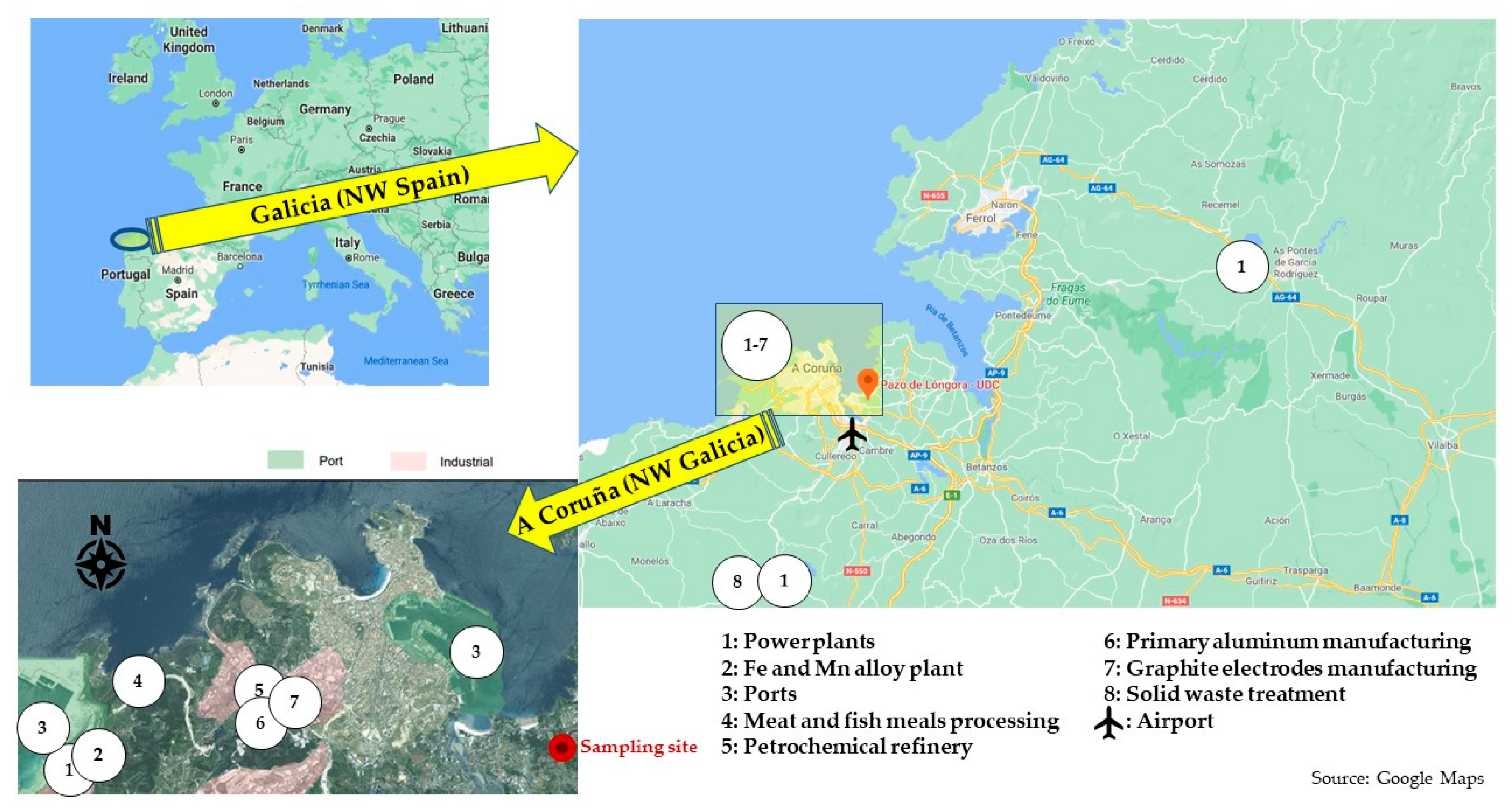
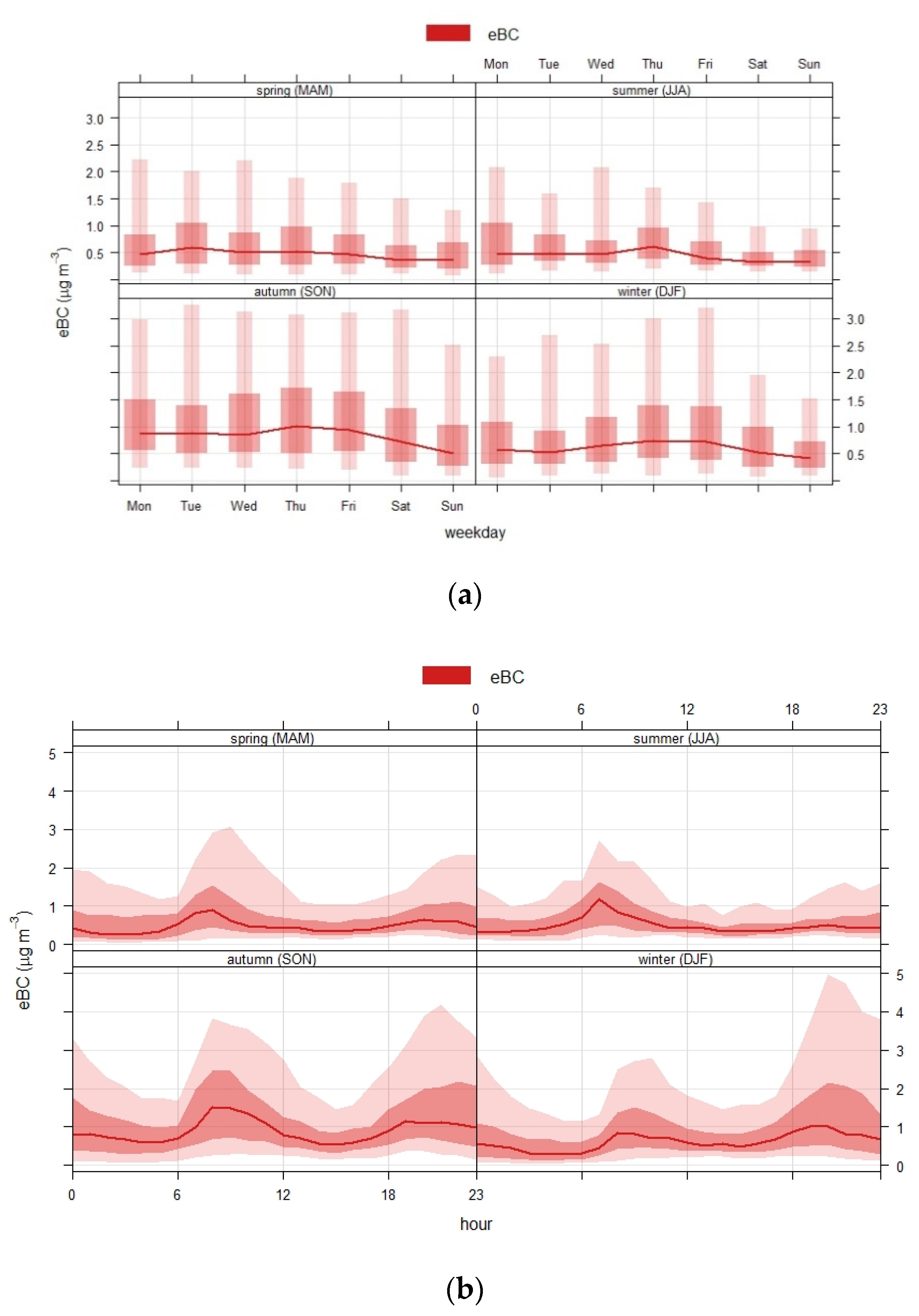
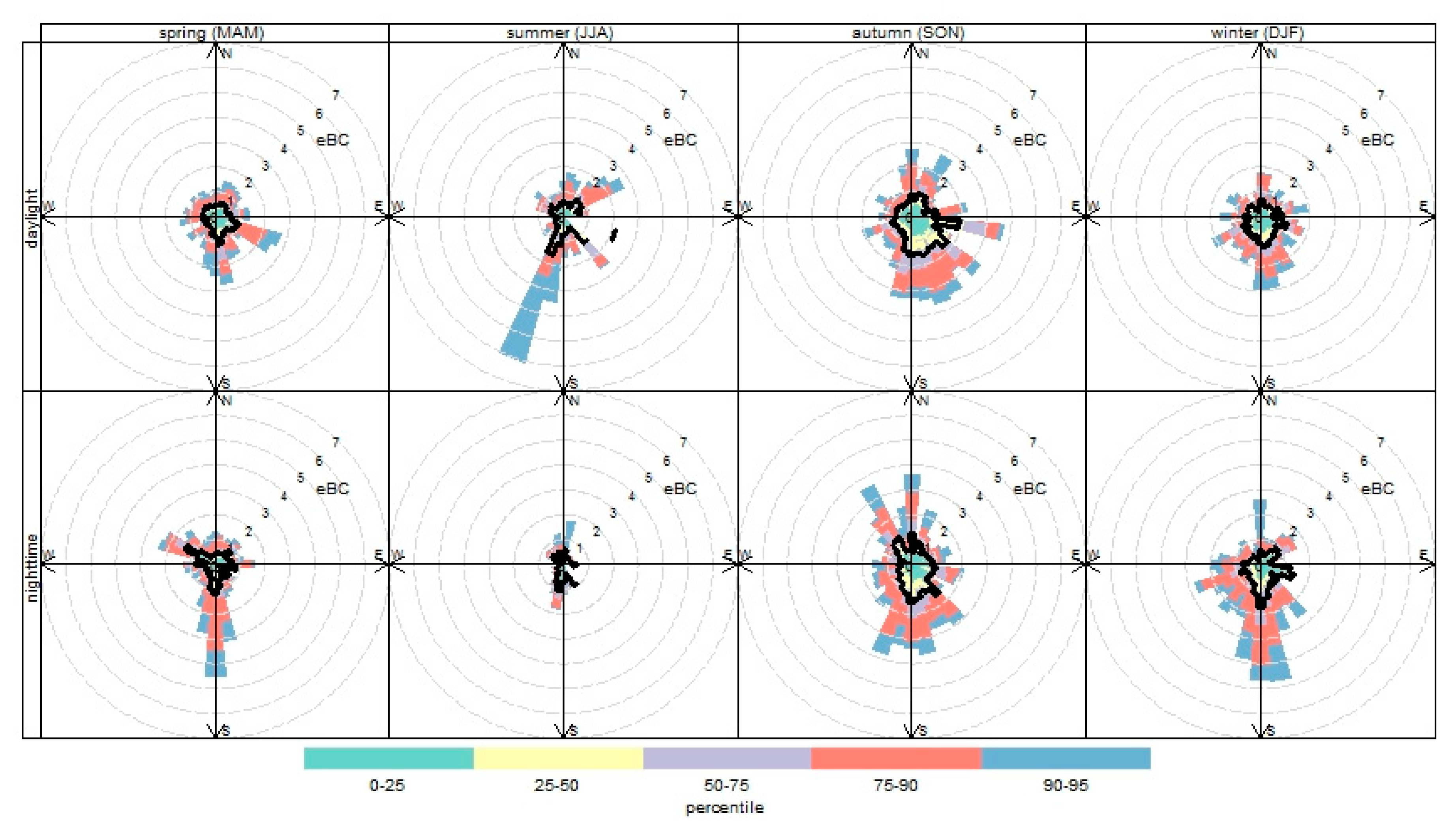
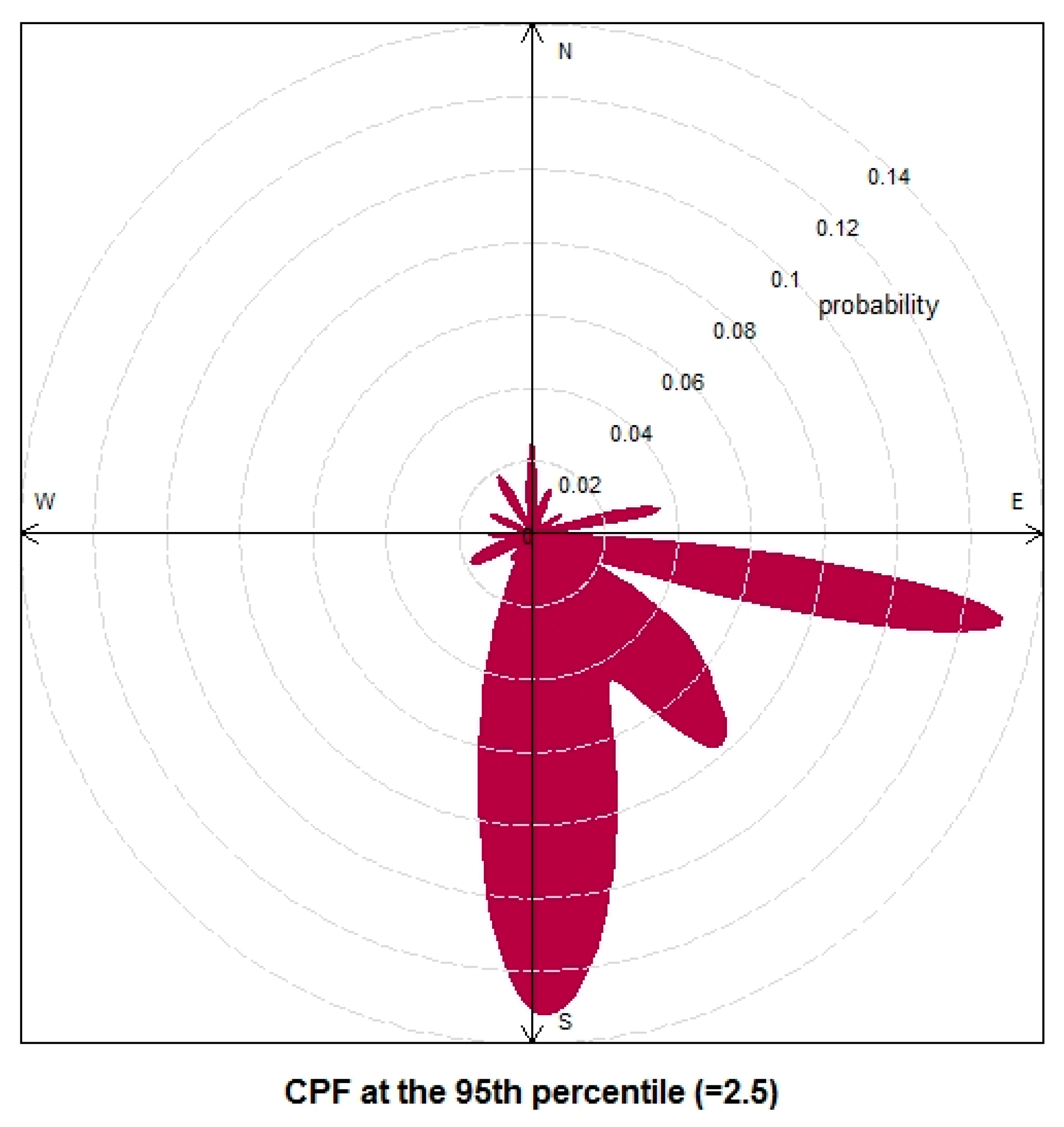
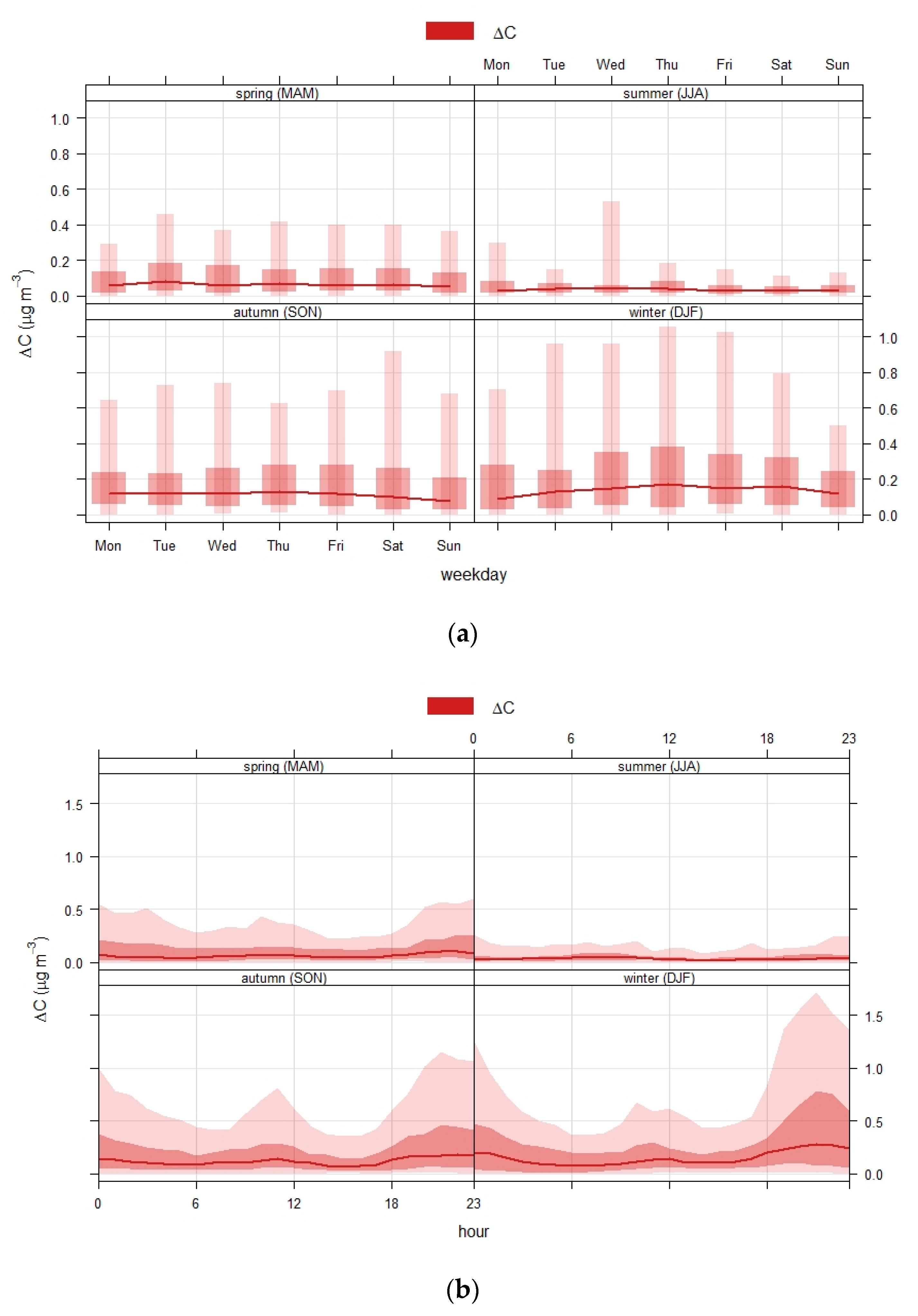
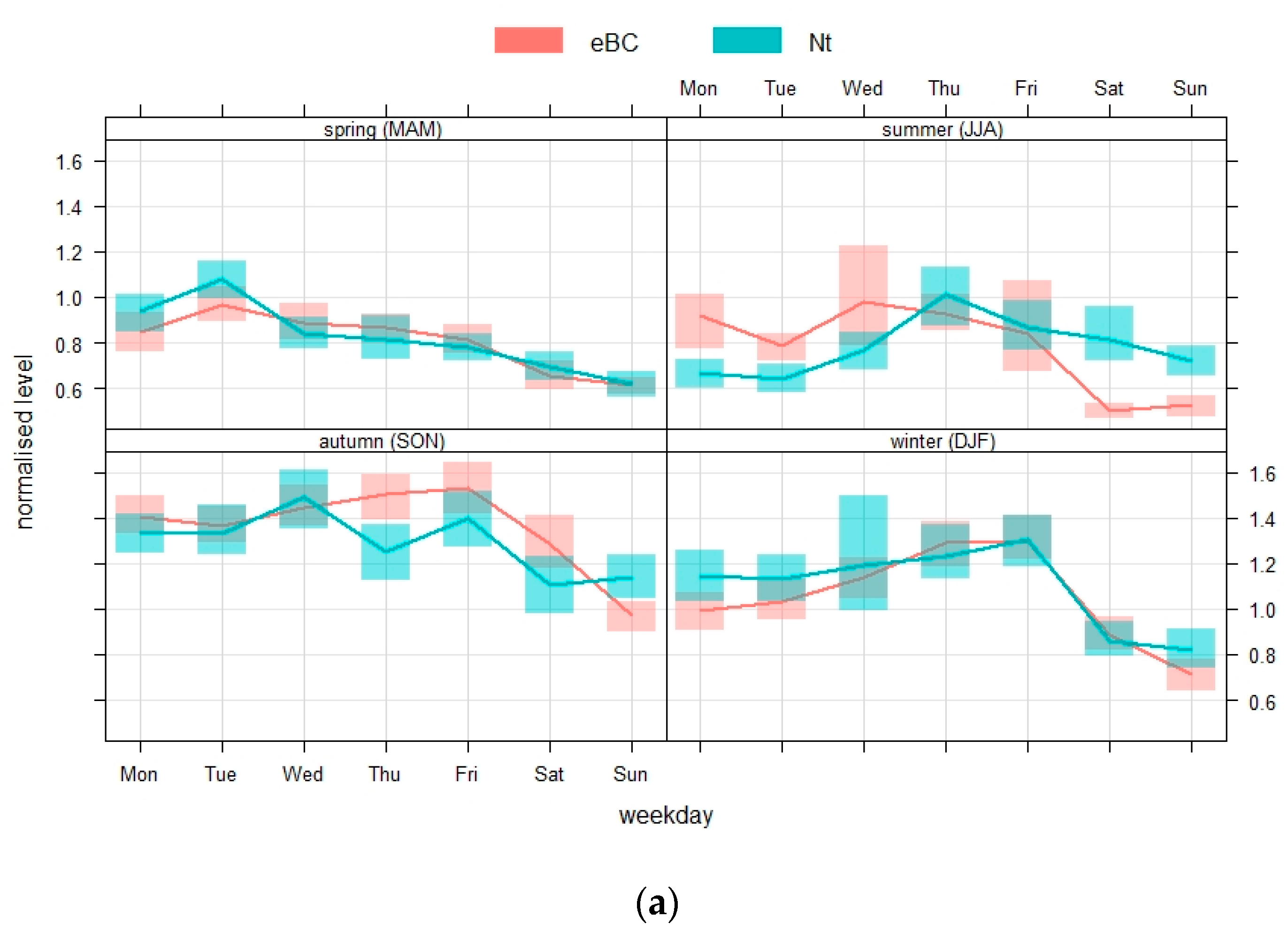
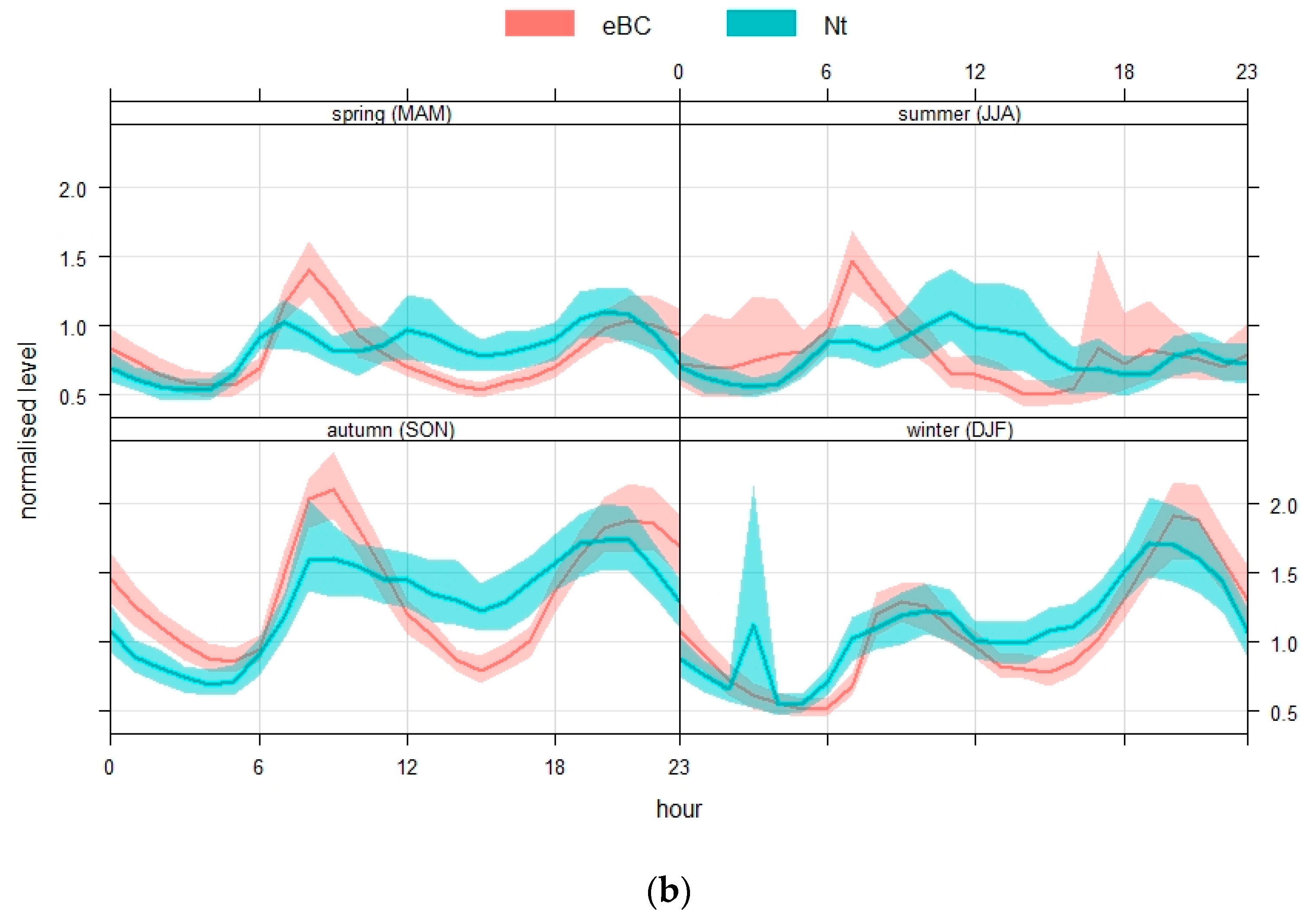
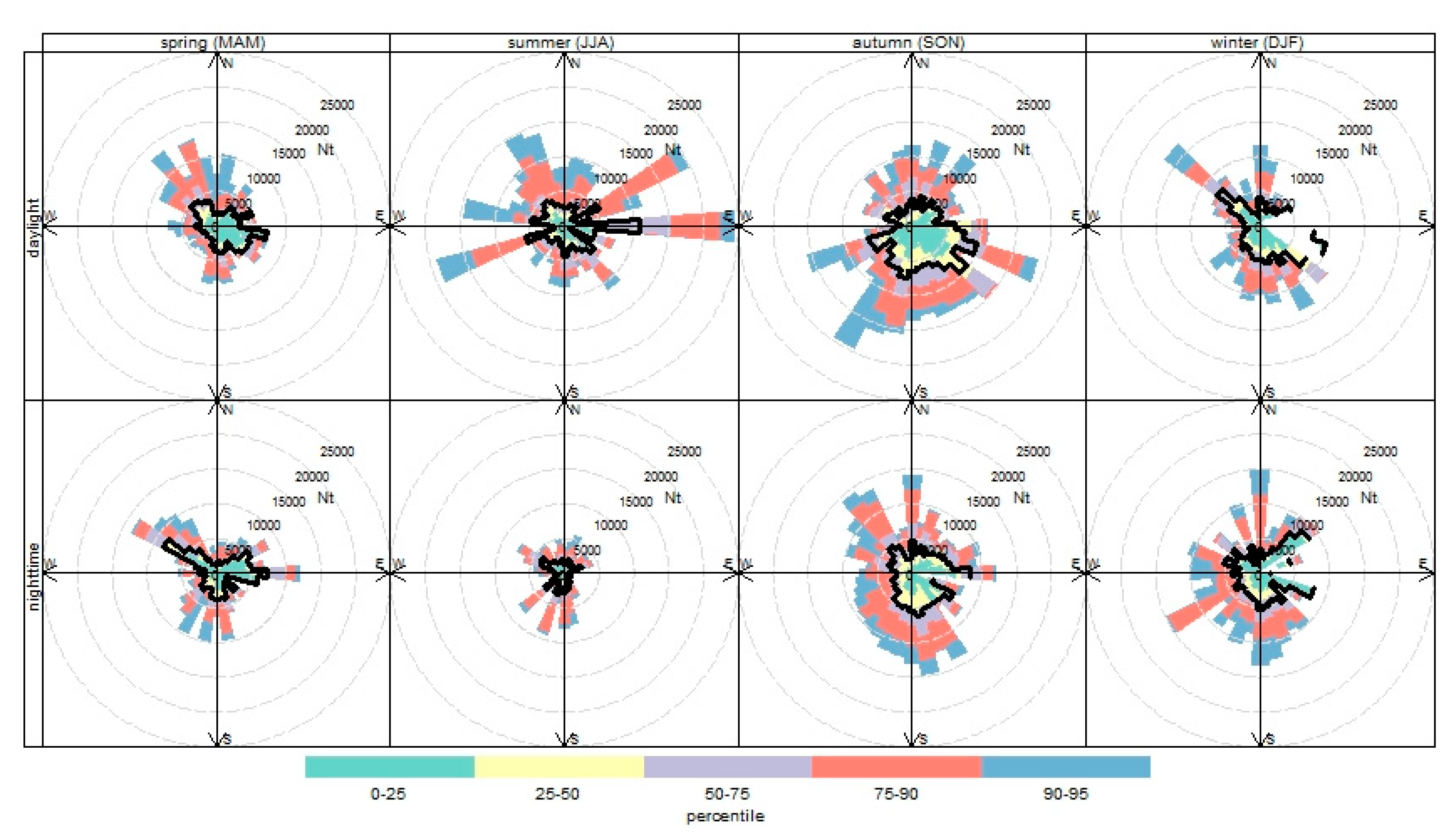
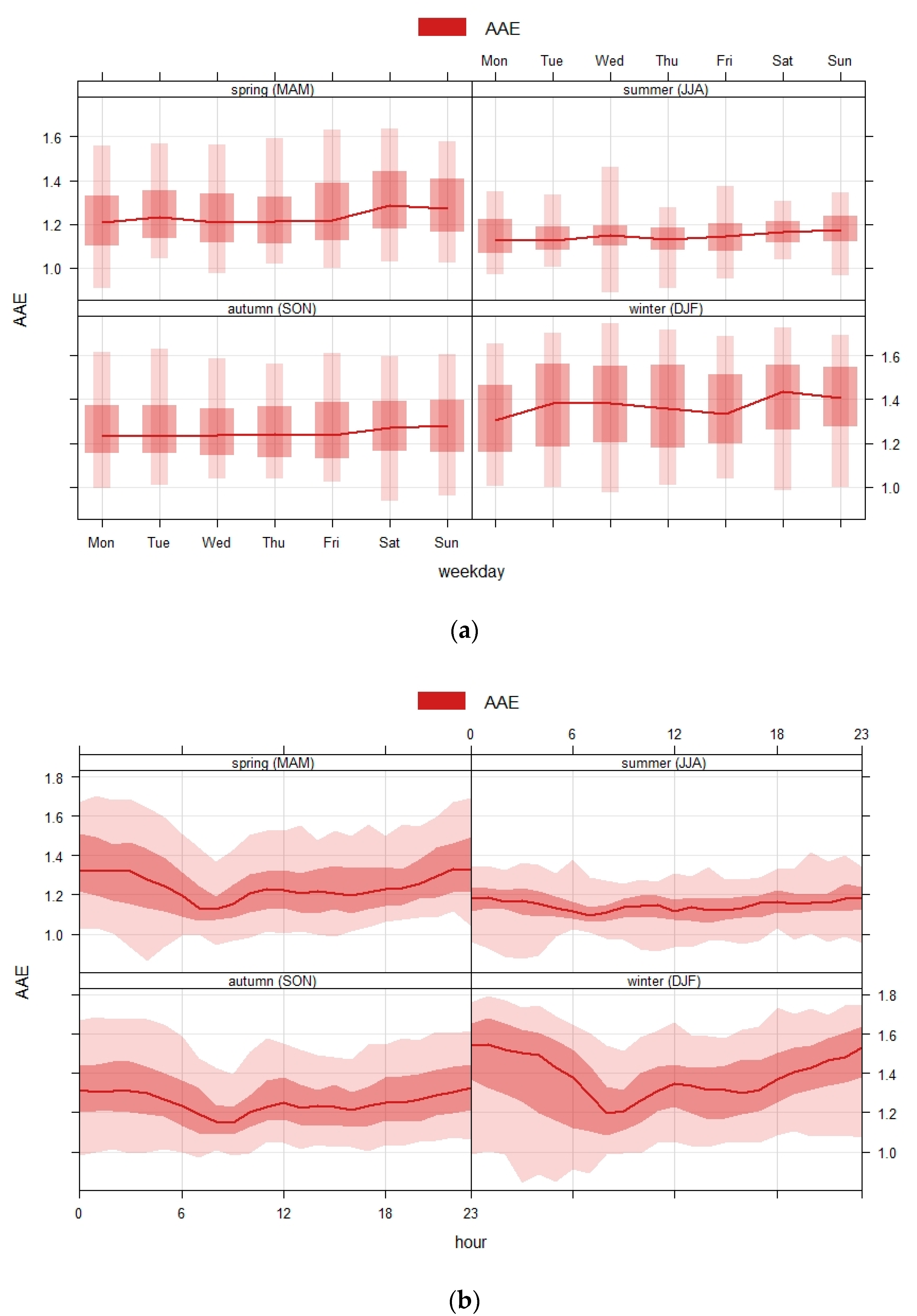
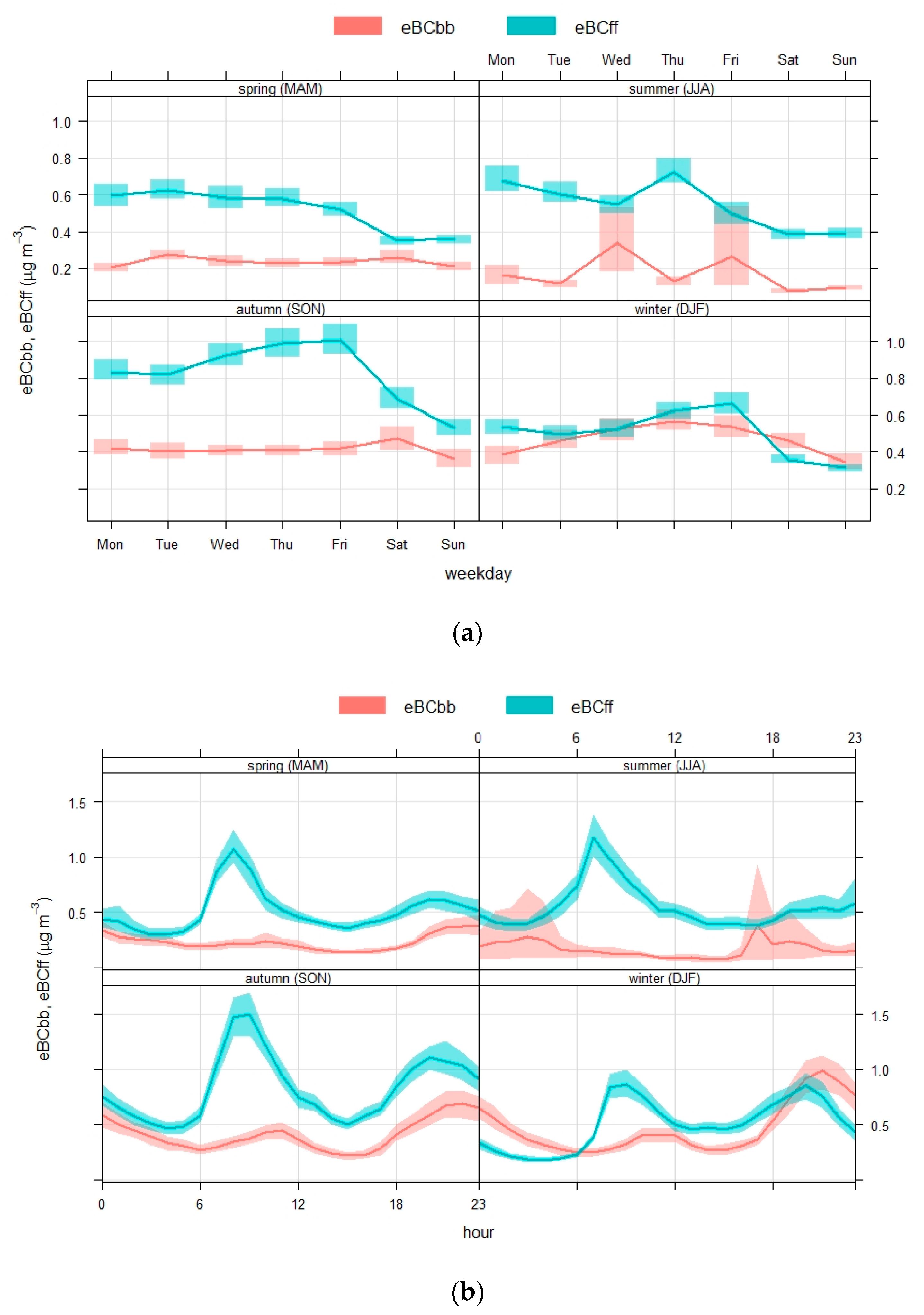
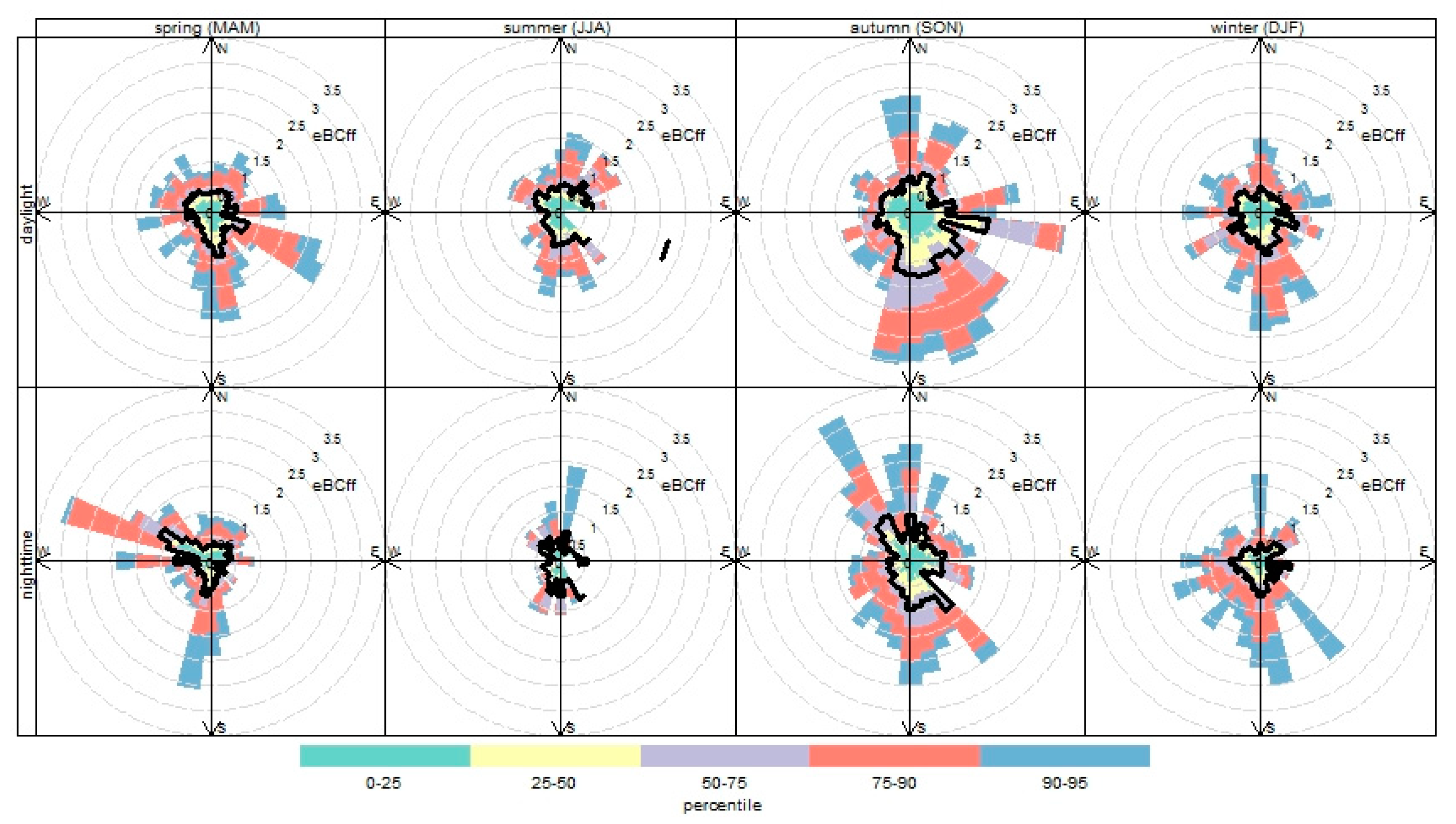
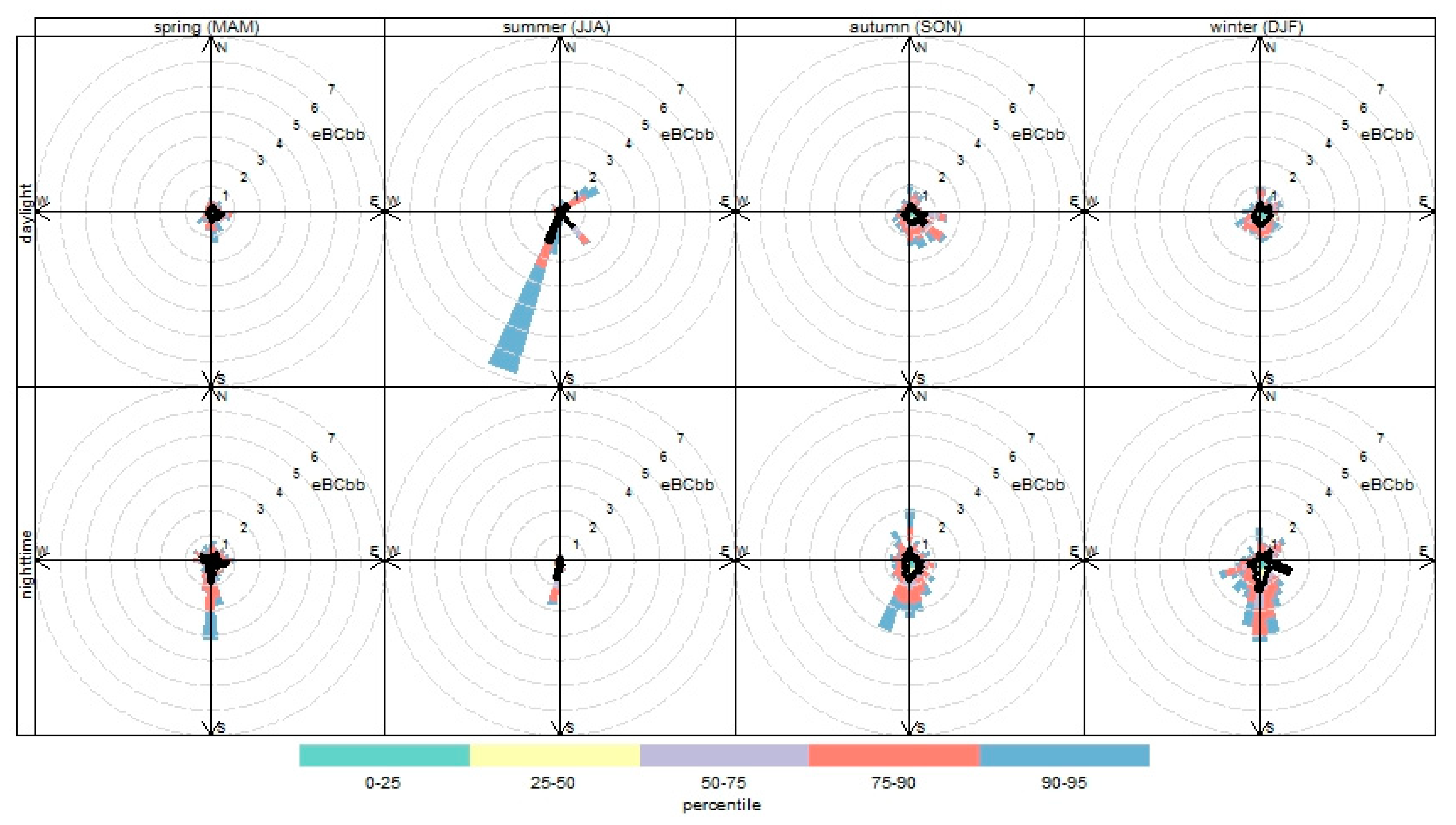
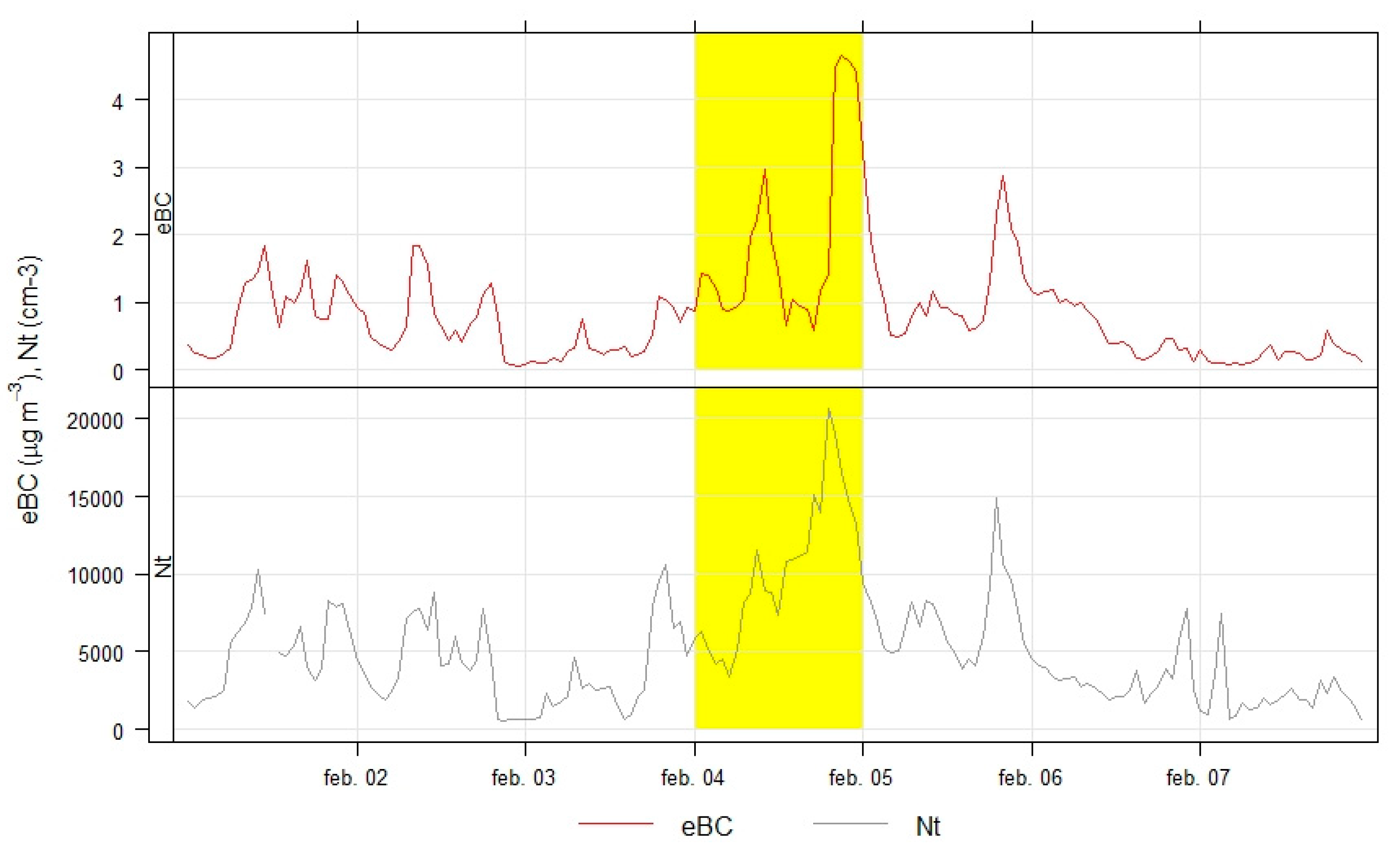
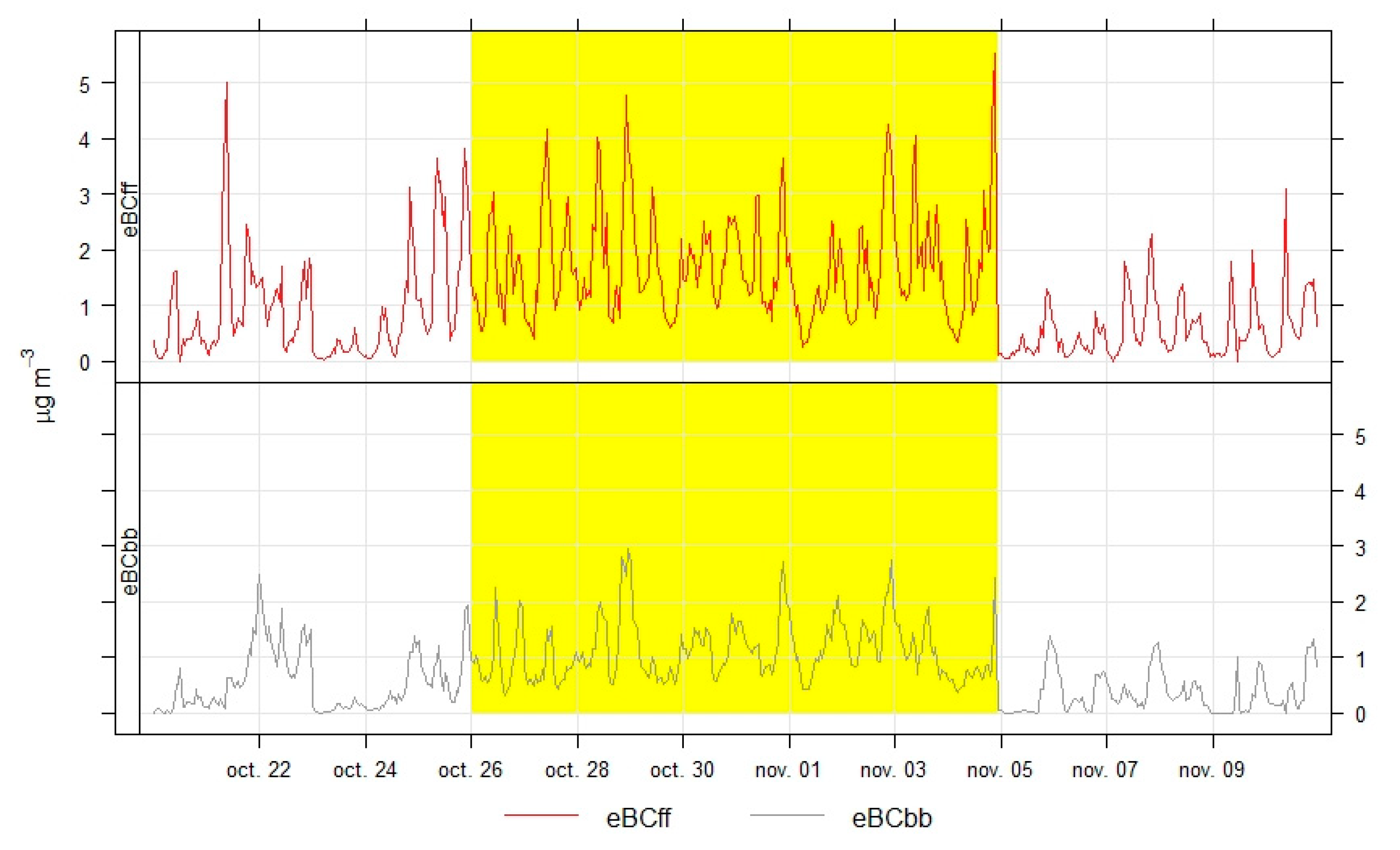
| Site | eBC (µg m−3) | Reference |
|---|---|---|
| Barcelona–CSIC (urban) | 2.1 | [14] |
| Granada University (urban background) | 2.6 | [4] |
| Madrid–Escuelas Aguirre (urban traffic) | 3.70 | [38] |
| Madrid–CIEMAT (urban background) | 2.33 | [38] |
| Jaén-Villanueva (rural) | 2.61 | [38] |
| Urban site–Helsinki metropolitan area | 1.69 | [39] |
| Suburban site–Helsinki metropolitan area | 0.88 | [39] |
| Ostrava (Czech Republic) | 3.48 | [40] |
| Rural, suburban, urban background, urban center and kerbside sites in UK | 0.45, 1.47, 1.34, 1.83 and 9.72, respectively | [41] |
| Urban site located in metropolitan Milan | 1.92 | [42] |
| Suburban site located in metropolitan Milan (Bareggio) | 2.76 | [42] |
| Urban background in Rome | 2.6 | [19] |
| Location | Period | Instruments | Nt (Diameter Range) | Reference |
|---|---|---|---|---|
| Granada University (urban background) | 12/04/2012–26/04/2012 22/04/2013–09/05/2013 16/10/2013–14/11/2013 | SMPS: electrostatic classifier (TSI 3080) and CPC (TSI 3776) | 7600 cm−3 (16.5–697.8 nm) 6900 cm−3 (16.5–697.8 nm) 11,900 cm−3 (16.5–697.8 nm), respectively | [21] |
| Urban background in Rome | 27/01/2017–28/02/2017 | TROPOS SMPS: CPC (TSI 3772) | 12,300 cm−3 (8–800 nm) | [19] |
| Urban background in Vienna | 01/01/2014–31/01/2015 01/06/2015–01/01/2016 | SMPS: Vienna type DMA and CPC (TSI 3775) SMPS: DMA (TSI 3081) and CPC 3772 or CPC3775, respectively | Median: 5395 cm−3 (10–550 nm) | [47] |
| Urban background in Prague | 01/01/2014–01/01/2016 | SMPS TSI 3034 | Median: 5844 cm−3 (10–550 nm) | [47] |
| AURN urban background (Leicester) (UK) | March–June 2014 | CPC TSI 3783 | 6837 cm−3 (10–1093 nm) | [15] |
| BF urban background (Leicester) (UK) | March–June 2014 | CPC TSI 3783 | 4737 cm−3 (10–1093 nm) | [15] |
Publisher’s Note: MDPI stays neutral with regard to jurisdictional claims in published maps and institutional affiliations. |
© 2021 by the authors. Licensee MDPI, Basel, Switzerland. This article is an open access article distributed under the terms and conditions of the Creative Commons Attribution (CC BY) license (http://creativecommons.org/licenses/by/4.0/).
Share and Cite
Piñeiro-Iglesias, M.; Andrade-Garda, J.; Suárez-Garaboa, S.; Muniategui-Lorenzo, S.; López-Mahía, P.; Prada-Rodríguez, D. Study of Temporal Variations of Equivalent Black Carbon in a Coastal City in Northwest Spain Using an Atmospheric Aerosol Data Management Software. Appl. Sci. 2021, 11, 516. https://doi.org/10.3390/app11020516
Piñeiro-Iglesias M, Andrade-Garda J, Suárez-Garaboa S, Muniategui-Lorenzo S, López-Mahía P, Prada-Rodríguez D. Study of Temporal Variations of Equivalent Black Carbon in a Coastal City in Northwest Spain Using an Atmospheric Aerosol Data Management Software. Applied Sciences. 2021; 11(2):516. https://doi.org/10.3390/app11020516
Chicago/Turabian StylePiñeiro-Iglesias, María, Javier Andrade-Garda, Sonia Suárez-Garaboa, Soledad Muniategui-Lorenzo, Purificación López-Mahía, and Darío Prada-Rodríguez. 2021. "Study of Temporal Variations of Equivalent Black Carbon in a Coastal City in Northwest Spain Using an Atmospheric Aerosol Data Management Software" Applied Sciences 11, no. 2: 516. https://doi.org/10.3390/app11020516
APA StylePiñeiro-Iglesias, M., Andrade-Garda, J., Suárez-Garaboa, S., Muniategui-Lorenzo, S., López-Mahía, P., & Prada-Rodríguez, D. (2021). Study of Temporal Variations of Equivalent Black Carbon in a Coastal City in Northwest Spain Using an Atmospheric Aerosol Data Management Software. Applied Sciences, 11(2), 516. https://doi.org/10.3390/app11020516






